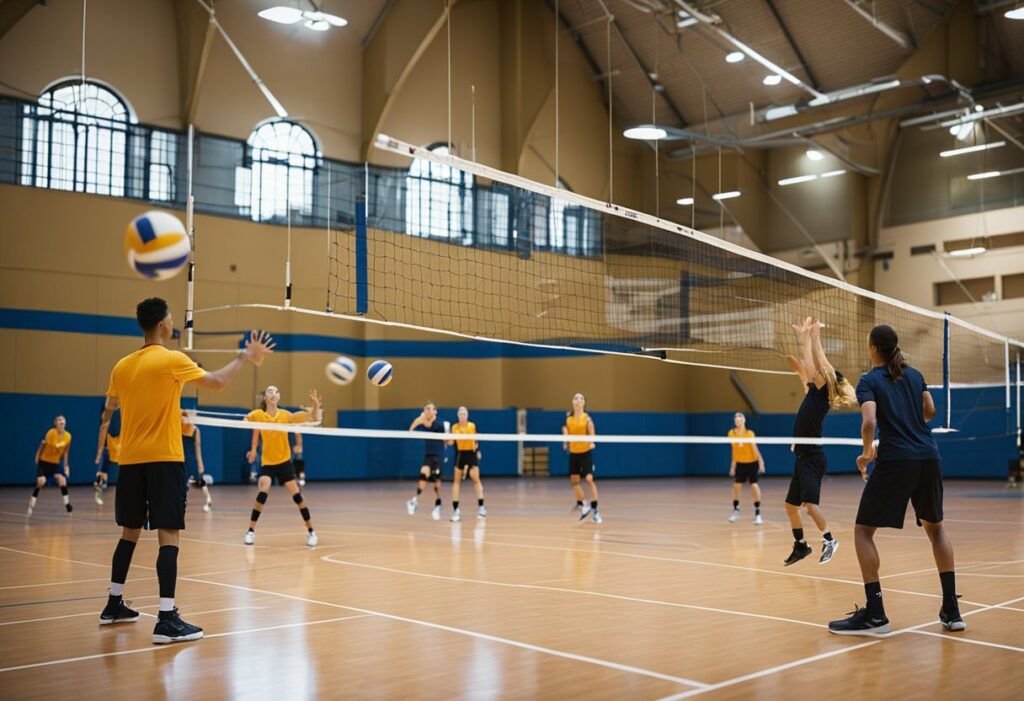Volleyball is an exciting sport that requires skill, teamwork, and practice. Players need to develop different techniques to improve their game, and digging is one of the most crucial skills for defensive players.
Digging drills help players enhance their reflexes and improve their ability to respond to powerful attacks.

Working on digging can greatly impact a team’s overall performance. By focusing on specific drills, athletes can build confidence and sharpen their skills.
Mastering these techniques allows players to stay competitive and contribute effectively to their team.
1: Cone Drills
Cone drills are a fun way to improve digging skills in volleyball. Players can set up cones in different patterns on the court. This helps them focus on movement and positioning.
One way to use the cones is to create a zigzag pattern. Players start at one cone and quickly move to the next. This drill helps them practice getting low and digging the ball effectively.
Another great idea is to place cones in a circle. Players can work on their footwork as they move from cone to cone. This drill also improves reaction time, which is key in digging.
Coaches can make the drills competitive too! Players can race to see who can complete the cone course the fastest. This adds excitement while they practice important skills.
Using cone drills regularly can lead to better digging techniques. With practice, players will feel more confident on the court. They will be ready to dig any ball that comes their way!
2: Wall Drills
Wall drills are a fun and effective way to improve digging skills in volleyball. Players can practice ball control by using a wall to help them. This drill helps them react quickly and build confidence.
To start, a player stands about six to eight feet away from a solid wall. They toss the ball against the wall and prepare to dig it back. Timing is key! Players should focus on getting low and using proper form when they dig.
Another variation is to have a partner toss the ball toward the wall. This adds a little challenge, as the player must adjust to the bouncing ball. They can practice different angles and speeds.
These drills can be done alone or with a friend. By practicing regularly, players will see improvement in their digging technique. It’s a great way for players to stay sharp and have fun at the same time!
3: Partner Toss
Partner Toss is a fun way to improve digging skills. In this drill, one player tosses the ball while the other practices digging. This helps players get comfortable with different ball heights.
To start, players stand a few feet apart. The tosser gently throws the ball to their partner. The receiver should focus on getting low and using their forearms to dig the ball.
It’s important for the player receiving the toss to keep their eyes on the ball. That way, they can react quickly and dive to make the dig if necessary. Practicing this regularly builds muscle memory.
As players get better, they can increase the speed and height of the toss. This adds a challenge and helps improve reaction time. The Partner Toss drill is great for developing teamwork as well. Players can provide feedback to each other.
This drill can be used to warm up before bigger practices or games. It encourages communication and helps build confidence. Players will enjoy the feeling of success as they master digging through Partner Toss!
4: Dive Roll Drill
The Dive Roll Drill is a fun way to improve digging skills in volleyball! It helps players learn to dive and roll safely on the court.
To start, players should find a soft surface. Grass or a soft gym floor works well. They begin by standing a few feet away from a partner who will toss a ball.
When the ball comes, players dive forward to hit it. They should tuck their chin and roll to absorb the impact. This motion helps avoid injury and prepares them for real game situations.
Practicing this drill builds confidence. It allows players to get used to diving and recovering quickly. With each roll, they get better at keeping the ball off the ground.
To make it more challenging, players can increase the speed of the toss. They might also dive from different angles. This keeps the drill exciting and helps improve their overall skill level.
The Dive Roll Drill is perfect for those who want to enhance their defensive play. With practice, players will feel more comfortable diving in games and saving those tough shots!
5: Lateral Shuffle
The lateral shuffle is a great drill for improving digging skills in volleyball. It helps players move quickly side to side. This movement is key for getting into position to dig the ball.
To start, a player stands with feet shoulder-width apart. They need to bend their knees slightly to stay low and balanced. The player then shuffles to the right a few steps, touching the ground with one hand at each step.
Next, they switch and shuffle to the left, keeping the same low position. This drill builds leg strength and agility. It also helps players react faster during games.
Practicing the lateral shuffle often can make a big difference. It teaches players to stay light on their feet. This skill is essential when digging for tough balls on the court.
Incorporating this drill into regular practice sessions can lead to better performance. Players will feel more confident moving quickly during a match. They can anticipate where the ball is going and get there in time to make the save!
6: 4-Corner Touch
The 4-Corner Touch drill is a fun way to improve digging skills. Players set up four cones in a square shape on the court.
To start, one player stands in the middle. The coach or another player will roll or hit the ball to each corner. The player in the middle must move quickly to touch each cone after receiving the ball.
This drill helps players get used to moving in different directions. It also promotes quick reactions and good body control. Players learn to stay low and position their bodies for an effective dig.
To make it more challenging, coaches can increase the speed of the ball. They can also change the order of the cones. This keeps players on their toes and engaged.
The 4-Corner Touch is a great way to mix practice and fun. It builds teamwork and communication, too. Players cheer each other on while working hard to improve their skills.
7: One-Handed Digs
One-handed digs are a fun and useful skill in volleyball. They allow players to make quick saves when the ball is coming fast and low. This technique can surprise opponents and save crucial points.
To practice one-handed digs, start in a ready position. Keep knees bent and feet shoulder-width apart. When the ball comes, extend one arm toward it. Use your hand to contact the ball, keeping your wrist firm.
He or she should aim to angle their hand to direct the ball where they want it to go. Quick reflexes are key! This drill can help increase confidence and improve agility on the court.
Players can also practice with a partner. One can toss the ball with different speeds and angles. This helps build reaction time and ensures that each dig becomes more accurate.
With practice, one-handed digs can become a reliable move in matches. They add excitement and skill to a player’s game. Keep training, and soon the player will shine!
8: Deep Ball Defense
Deep ball defense is crucial in volleyball. It helps players react quickly to high, powerful attacks from opponents. Practicing this skill can really improve a team’s performance.
Players should focus on their positioning. They need to be ready to move back and cover the court. Having good footwork is important. It helps players get to the ball faster.
Drills for deep ball defense can include high balls tossed or hit from a distance. Players can practice diving or rolling to reach the ball. This builds both confidence and technique.
Teamwork is also key. Players should communicate clearly, calling for the ball and supporting each other. Practicing defensive strategies together can boost their overall effectiveness during games.
Another great way to improve is through video analysis. Watching recordings can show players where they can improve. They can see their movements and learn from each play.
Deep ball defense is exciting and challenging. With practice and focus, players can master this important skill. They will feel more prepared to face tough opponents and make amazing digs!
9: Kneeling Digs
Kneeling digs are a fun and effective drill for improving a player’s ability to dig low balls. In this exercise, players start on their knees. This position forces them to focus on their hand placement and body control.
To begin, they should position their hands in front of them, ready to receive the ball. A coach or teammate can toss or hit the ball toward them. The goal is to make a solid contact and direct the ball back up, using the forearms.
Practicing kneeling digs helps players build strength and stability. It also enhances their reaction time. By repeating this drill, they can become more comfortable with low balls during games.
Kneeling digs are great for teams at any skill level. They encourage teamwork and communication. Players can cheer each other on while improving their skills. This drill is all about getting better while having fun!
10: Three Ball Drill
The Three Ball Drill is a fun and exciting way to improve digging skills in volleyball. It’s perfect for players at all levels.
In this drill, three players line up in the back row. One player acts as the server and sends the ball over the net. The other two players take turns digging the ball, focusing on proper technique.
After each player has had a turn, they switch roles. This keeps everyone involved and allows for lots of practice. Players learn to react quickly and move their feet.
This drill can be adjusted based on the team’s skill level. Coaches can vary the speed and angle of the serves. This helps players get used to different types of digs they might face during a game.
Having fun while practicing is key. The Three Ball Drill not only enhances skills but also builds team chemistry. Players cheer each other on, creating a positive environment where everyone can grow.
Note: For more volleyball drills, you can check my ultimate volleyball drills guide here.
Fundamentals Of Volleyball Digging
When digging in volleyball, proper technique is crucial. Two main aspects help players improve: body positioning and hand placement. Mastering these areas leads to better digs and saves crucial points during matches.
Body Positioning
Effective body positioning starts with the feet. Players should keep their feet shoulder-width apart to ensure balance.
They also need to lower their hips and bend their knees slightly. This position helps them react quickly to incoming balls.
A low center of gravity is vital. It allows the player to stay grounded and agile. While digging, they should slightly lean forward, keeping their shoulders over their feet. This stance prepares them to move in any direction.
Lastly, a player should always be ready. Keeping eyes on the ball ensures they can make the best dig possible when it counts.
Hand Placement
Hand placement plays a key role in successful digs. Players should form a platform with their arms. To do this, they should bring their hands together, keeping thumbs aligned.
The arms should extend in front of the body. This creates a stable surface to receive the ball. Keeping elbows locked helps with control and accuracy.
Players must also focus on the angle of their hands. A slight tilt forward directs the ball upward. This technique helps set up their teammates for the next play.
When digging, it’s important for players to maintain a firm grip. Loose hands can lead to inaccurate digs, making it harder to respond effectively in tight situations.
Common Mistakes To Avoid
When practicing volleyball digging drills, players often make specific mistakes that can hinder their skills. Understanding these common errors can help players improve their game.
Incorrect Stance
An improper stance can greatly affect a player’s ability to dig successfully. Players often stand too upright or too far back, which makes it difficult to react to incoming balls.
The ideal stance involves bending the knees slightly and positioning the feet shoulder-width apart. This stance allows for better balance and quick lateral movement.
A common mistake is pointing toes too far out. This can lead to a loss of balance when it’s time to move. Players should keep their toes pointed forward to maintain stability and control during plays.
Late Reactions
Timing is crucial in volleyball. Many players react too slowly to the ball, which results in missed digs. A key factor in improving reaction time is anticipation.
Players should focus on watching the setter and understanding where the ball will go. This anticipation allows them to move into position quicker.
Another mistake is hesitating before moving. Players often freeze up when they see the ball coming, which slows their response. Practicing quick footwork drills can help players learn to react faster during a game.

